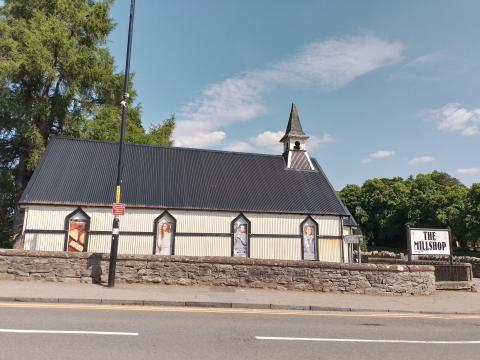Fort Augustus' Tin Tab

The 'tin tabernacle' was a popular late-Victorian and Edwardian style of church building. This one is situated in the Highlands at Fort Augustus. It is now a mill shop, and has been since the 1970s, though it was originally, in 1906, a Free Church until rejoining the Church of Scotland in 1929.
Tin tabs were cheaper and quicker to erect than traditional stone or brick churches, which well suited the Victorians’ enthusiasm for ecclesiastic construction. Architectural snobs like William Morris decried them as a ‘pestilence’, but congregations with limited funds were well served by their construction. David Rowell & Co's 1901 catalogue advertised an 'iron church' with a capacity for 400, including transport to the nearest railway station and erection on an existing foundation, that would cost a mere £360. Salem Chapel cost £500 two generations before that.
Yet whether churches be made of stone, brick, wood or tin, none can be certain to remain open. Those with a penchant for converting chapels to homes are today spoilt for choice, especially north of the border where the Church of Scotland seems to be haemorrhaging churches at a terminal rate. No, it is not the material of a building’s construction that assures its permanence, but its faithfulness to God’s word. Show me a church that is meeting inside a building constructed of straw and mud, and it will still be meeting for decades if it is true to the Bible. Assemble in a grand cathedral while betraying the lively oracles of God, and expect to be propped up by selling trinkets to tourists and holding concerts for the godless.
Therefore saith the Lord, the Lord of hosts, the mighty One of Israel, Ah, I will ease me of mine adversaries, and avenge me of mine enemies: And I will turn my hand upon thee, and purely purge away thy dross, and take away all thy tin: Isaiah 1:24-26, AV
- Log in to post comments


 Sunday Worship 10.45am & 6.00pm
Sunday Worship 10.45am & 6.00pm